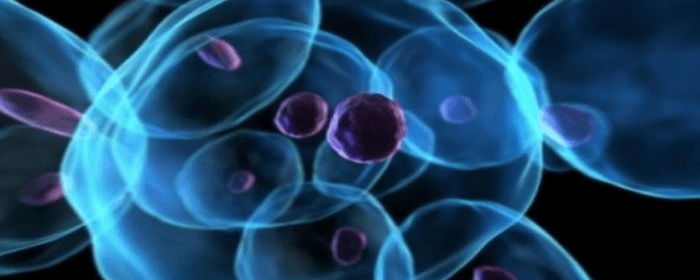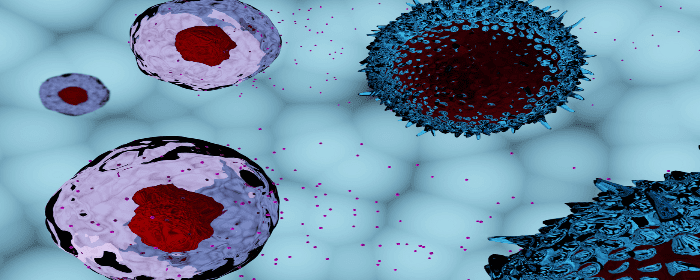
by admin | Dec 3, 2020 | Exosomes, Mesenchymal Stem Cells, Stem Cell Research, Stem Cell Therapy, Stroke
Promising early research shows that when introduced into a brain injured by stroke, extracellular vesicles (EVs), also known as exosomes, a bioactive substance secreted by mesenchymal stem cells, have been associated with improved blood vessels creation, increased formation of neurons, and enhanced preservation of the neurological structure; these findings demonstrate a promising stem cell-derived stroke therapy that serves as an alternative approach to current stem cell infusion treatment options.
With nearly 14 million people suffering strokes each year, strokes continue to be the leading cause of physical disability among adults; between 25 percent and 50 percent of stroke survivors are left with significant and debilitating disabilities.
Because mesenchymal stem cells, or MSCs, secrete extracellular vesicles thought to reduce inflammation, enhance autophagy, and promote regeneration of damaged cells, researchers evaluating potential regenerative strategies for stroke-induced neurologic deficits have identified these MSC-derived EVs as a viable option for stroke therapy.
Although the reported beneficial effects of EV therapy has been observed in studies completed on animals, there is an increasing number of clinical studies currently being conducted on humans that suggest MSC EV stem cell therapy is a potentially safe and effective therapeutic option to improve outcomes in several various human applications.
Specifically, this EV-mediated therapy appears to offer an off-the-shelf treatment option that is potentially effective in crossing the blood-brain-barrier (BBB) while also avoiding cell-related problems, including the formation of tumors and infarcts resulting from vascular occlusions, or blood clots, consistent with those observed in acute ischemic stroke.
While there appears to be a promising upside to MSC EV therapy for the treatment of stroke, studies are on-going to discover the optimal therapeutic treatment of stroke patients. Some areas to continue researching are the optimal time and best mode of application of EVs in stroke patients (most stroke-related recovery occurs in the first few months following the stroke).
As research continues into the effectiveness of MSC-EV therapy for stroke, early indications are that EVs derived from mesenchymal stem cells could be a viable cell-free treatment option for patients recovering from a severe stroke.
Source: (2019, March 12). Mesenchymal Stem Cell-Derived Extracellular Vesicle …. Retrieved December 4, 2020, from https://www.ncbi.nlm.nih.gov/pmc/articles/PMC6422999/

by admin | Oct 24, 2020 | Exosomes, Osteoarthritis, Stem Cell Therapy
Osteoarthritis is a disease in which joint cartilage degenerates and the bony edges of the joint rub against each other. The disease causes pain and disability in the affected joint. There is no cure for osteoarthritis, except perhaps for artificial joint replacement surgery. Patients who are not candidates for surgery must get by with pain medications, braces, and physical therapy.
Given that osteoarthritis affects millions of people and there are limited options for long-term treatments other than major surgery, researchers are working very hard to find additional ways to manage this condition. One of the most exciting developments has been in the field of regenerative medicine, also known as stem cell therapy.
Stem cells injected into arthritic knees, for example, may help reduce the patient’s pain, protect cartilage, or even slightly heal the joint damage. Many patients feel relief and see improvements from just one therapy. Some with more advanced conditions may require a more maintenance plan. But today, researchers are now focused on the mesenchymal stem cell secretome.
What is a mesenchymal stem cell secretome? A mesenchymal stem cell secretome is the total of all of the molecules that mesenchymal stem cells secrete or release to support, restore, and regenerate tissue. The molecules released from mesenchymal stem cells, mostly through stem cell exosomes, exert many powerful benefits on joints.
From laboratory experiments in animals, we know the mesenchymal stem cell secretome is anti-apoptotic, which means it protects joint cells from committing programmed cell suicide. The secretome is also anti-fibrotic, and fibrosis can be damaging to joints and make them stiff. The secretome is pro-chondrogenic and pro-angiogenic, which means it helps build cartilage and blood vessels, respectively.
Lastly, the mesenchymal stem cell secretome modulates the immune system. While rheumatoid arthritis is considered the major inflammatory joint disease, inflammation also takes place in osteoarthritis. So, the mesenchymal stem cell secretome can modulate the immune system and reduce joint inflammation.
The main way that patients can reap the potential benefit of the mesenchymal stem cell secretome is through exosomes. Exosomes are small particles that contain most of the substances released in the secretome. Exosome treatment does not require stem cell infusions, and many, many more exosomes can be administered during a treatment session than stem cells, mainly because they are physically much smaller.
The concept of mesenchymal stem cell secretome is rather new, but it is a powerful concept in the treatment of osteoarthritis. As more human clinical studies are done, we should be able to unlock the power of the secretome for patients with osteoarthritis.
Reference: Mancuso P, Raman S, Glynn A, Barry F, Murphy JM. Mesenchymal Stem Cell Therapy for Osteoarthritis: The Critical Role of the Cell Secretome. Front Bioeng Biotechnol. 2019;7:9. Published 2019 Jan 29. doi:10.3389/fbioe.2019.00009

by admin | Jul 14, 2020 | Exosomes, Stem Cell Therapy
Over the past decade, scientists have learned that the molecules that mesenchymal stem cells release are every bit as important to regenerative medicine as the stem cells themselves. Stem cells release exosomes, which are tiny packets that contain countless molecules of microRNA, cytokines, and growth factors. These molecules are mainly what allows stem cells to help the body regrow and repair.
Dr. Vizoso and colleagues published a review article that describes the many benefits of the secretome, that is, stem cell exosomes and the substances they produce. They not only explain why exosomes are helpful in regenerative medicine but why stem cell exosomes bring a powerful enhancement to stem cells themselves.
Compared to exosomes, whole stem cells are rather big—one can safely inject far more exosomes than stem cells in each treatment. And, really, it seems that the stem cell exosomes are what is supplying most of the benefits.
Stem cells can be made to produce millions of exosomes. These stem cell exosomes can then be collected, stored, shipped, and infused with much less cost and aggravation than stem cells themselves. Exosomes have small molecules on their surfaces that allow them to seek out and find areas in the body where they are needed. Stem cells often need to be injected near the site of injury. Exosomes may work if simply infused into a vein.
Dr. Vizoso and coauthors make a persuasively strong argument about the potential benefits of infusing stem cell exosomes instead of stem cells themselves. They also point out the potential limitations of the process, given the current technology. For example, stem cells would need to be made “immortal” so that they can keep producing large amounts of the same sorts of exosomes over time. Fortunately, the techniques of cell immortalization have been around for at least 30 years. Thus, most of the barriers to widespread, large scale exosome use are things scientists already know how to overcome.
While there may still be benefits for direct stem cell infusions, the future of research is moving forward with stem cells and exosomes.
Reference: Vizoso, F., et al. (2017). Mesenchymal Stem Cell Secretome: Toward Cell-Free Therapeutic Strategies in Regenerative Medicine. International Journal of Molecular Sciences. 2017, 18(9), 1852.

by admin | Jul 5, 2020 | Exosomes, Osteoarthritis, Stem Cell Therapy
Odds are, you or someone you know has osteoarthritis—it is that common. Osteoarthritis is a chronic inflammation and destruction of one or more joints. Osteoarthritis is the kind of arthritis most people think of when they think of “arthritis.” The disease usually causes joint pain, stiffness, and limited joint motion. Common sites of osteoarthritis are the hands, knees, feet, spine, and hips.
Unlike rheumatoid arthritis, there are few good treatments for osteoarthritis. Most people with advanced disease must take analgesics (painkillers) each day to dull the pain. Unfortunately, each painkiller comes with its own problems. Aspirin increases the risk of bleeding. NSAIDs like ibuprofen wreak havoc on the gastrointestinal system and affect the kidneys. Chronic acetaminophen can be harmful to the liver. Opioids come with the risk of dependence and addiction. The only definitive treatment for osteoarthritis is surgery, which is expensive and usually requires a long recovery period.
Mesenchymal stem cells, also known as stromal cells, have shown remarkable promise in the treatment of osteoarthritis. For example, mesenchymal stem cells taken from bone marrow or fat tissue (adipose) that are then injected into joints can protect the joint from degeneration and slow the progression of osteoarthritis. However, there are some limitations with stem cell treatment. One issue is that only so many cells can be injected in a space at once. For these reasons, scientists have pivoted some of their focus from stem cells to the tiny packets of information stem cells release called exosomes.
Exosomes contain millions of beneficial molecules including small proteins, cytokines, RNA, microRNA, and DNA. One stem cell can release thousands of exosomes. Since the exosomes are so small, many more exosomes can be collected and injected than stem cells themselves.
Researchers recently showed that exosomes collected from mesenchymal stem cells were able to provide the same benefits against osteoarthritis in mice as bone marrow stem cells did themselves. Stem cells slowed down the clinical signs of arthritis in mice just as whole stem cells did. Exosomes also protected cartilage and other joint structures from destruction.
This research demonstrates the developing science to use exosomes to treat osteoarthritis instead of the stem cells themselves. This gives doctors (and patients) considerably more flexibility in how they approach treatment. Exosomes tend to find their way to sites of disease, meaning they may be able to be injected into a vein instead of injected in the diseased joint. In addition, patients may be able to receive a higher “dose” of exosomes when simply purified exosomes are injected. This exciting research will need to be extended to humans, but clinical trials are in the planning phase.
Reference: Cosenza, S., Ruiz, M., Toupet, K. et al. Mesenchymal stem cells derived exosomes and microparticles protect cartilage and bone from degradation in osteoarthritis. Sci Rep 7, 16214 (2017).

by admin | Jun 26, 2020 | Traumatic Brain Injury, Exosomes, Stem Cell Therapy
Traumatic brain injury is a single name given to a broad variety of conditions. In every instance of traumatic brain injury, some external force causes damage to the brain. This may be mild and short-lived, such as a concussion, or severe and permanent, such as severe head trauma. The initial trauma or injury can cause a number of injuries to the skull and brain such as skull fracture, cerebral contusion (“brain bruise”), cerebral edema (“brain swelling”), or hemorrhage (“brain bleed”).
Traumatic brain injury can also cause several secondary injuries that may continue for hours or days. The secondary effects of traumatic brain injury include:
- Electrolyte imbalances
- Mitochondrial dysfunction
- Inflammation
- Ischemia (lack of blood flow to parts of the brain)
- Brain cell destruction
These secondary traumatic brain injuries can cause long-term and even permanent neurological dysfunction.
Unfortunately, there are very few treatments for traumatic brain injury. Neurosurgeons can sometimes stop brain bleeding, stabilize skull fractures, and reduce brain swelling; however, there is little that can be done to stop the secondary effects of traumatic brain injury. Doctors have tried using steroids or hypothermia (cooling the patient) to decrease inflammation and stop further injury, but these interventions are not highly effective.
Ideally, one would give a treatment soon after a person has had a traumatic brain injury. This treatment would reduce or block the secondary effects of traumatic brain injury. Scientists are studying whether stem cell treatment can do that very thing.
Researchers recently showed that exosomes from bone marrow mesenchymal stem cells were able to reduce the secondary effects of traumatic brain injury. They humanely caused a traumatic brain injury in a group of mice. Fifteen minutes after the TBI, half the mice were given an injection of stem cells and the other half received a placebo (i.e. saltwater).
The mice that received the stem cell exosome treatment did substantially better than the mice who received a placebo. Stem cell exosome treatment substantially reduced the size of the damage to the brain compared to control. Moreover, mice that received stem cell exosome treatment did better on sensory, motor, reflex, and balance tests. In other words, stem cell exosome treatment helped mice with traumatic brain injury move better than those that did not receive stem cell exosome treatment.
The scientists went on to show that exosome treatment helped block the secondary effects of traumatic brain injury on the cellular and molecular level. In short, stem cell exosome treatment reduced inflammation in the brain from TBI.
Taken together, these results strongly suggest that treatment with exosomes from bone marrow mesenchymal stem cells soon after traumatic brain injury has the ability to protect the brain from damage. Of course, this treatment will need to be tested in humans who have had incidental TBI. Nevertheless, the basic science results are quite exciting since few neuroprotective agents, if any, can block the secondary effects of traumatic brain injury the way exosomes did in this scientific report.
Reference: Haoqi, N., et al. (2019). Exosomes Derived From Bone Mesenchymal Stem Cells Ameliorate Early Inflammatory Responses Following Traumatic Brain Injury. Frontiers in Neuroscience. 2019 Jan 24; 13:14.

by admin | Jun 12, 2020 | Exosomes, Stem Cell Therapy
Many clinical studies have shown the safety and benefit of exosomes. As a result, numerous companies have been bringing exosome products to market. However, not all exosomes are the same. The cell type from which the exosomes are collected makes an enormous difference in safety and results.
Scientists have recently drawn attention to the fact that cell type matters when it comes to exosomes. Virtually every cell in the human body releases small packets of substances called exosomes. The number of exosomes and the substances inside exosomes can vary considerably, depending on the type of cell. Exosomes derived from stem cells and stromal cells have received the most research attention. That is because exosomes from stem cells contain most of the substances that provide a benefit to patients from stem cells. In other words, if you receive treatment of exosomes from stem cells, you are basically getting additional benefits from the exosomes that you would have gotten from just the stem cells themselves. However, the source of the stem cell exosomes matter.
Most of the research done in this area revolves around two types of stem cells: Exosomes taken from bone marrow mesenchymal stem cells and exosomes taken from placental mesenchymal stem cells. Bone marrow stem cells seem to have two major advantages over the placenta-derived stem cells. The first is that bone marrow stem cells have a stronger ability to modulate the immune system. The second is that bone marrow stem cells have immune privilege, which means they can avoid the body’s immune system. Specifically, placenta stem cell exosomes contain higher levels of PDL1 and HLA-G, which can make them more likely to provoke a negative immune response.
Surprisingly but reasonably, there have been of 63,000 scientific articles published on the safety and efficacy of bone marrow stem cells, but only about 1,200 on placenta stem cells.
Talk to your stem cell and exosome provider about your choices of exosomes, and make sure to ask from what cell type the exosomes are derived.
Reference: Hicok, Kevin & Vangsness, Thomas & Dordevic, Maxwell. (2020). Exosome Origins: Why the Cell Source Matters. 4. 1-4.







 St. Petersburg, Florida
St. Petersburg, Florida
